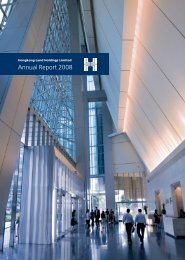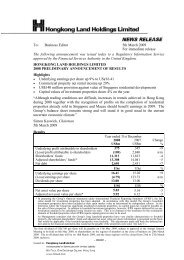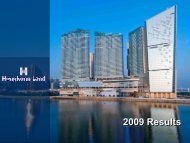Annual Report 2011 - Hongkong Land
Annual Report 2011 - Hongkong Land
Annual Report 2011 - Hongkong Land
Create successful ePaper yourself
Turn your PDF publications into a flip-book with our unique Google optimized e-Paper software.
1 Principal Accounting Policies continued<br />
Basis of preparation continued<br />
Standards and amendments effective after <strong>2011</strong> which are relevant to the Group’s operations and yet to be adopted<br />
continued<br />
IAS 19 (amended <strong>2011</strong>) ‘Employee Benefits’ (effective 1st January 2013) requires the assumed return on plan assets recognised<br />
in the profit and loss to be the same as the rate used to discount the defined benefit obligation. It also requires actuarial gains<br />
and losses to be recognised immediately in other comprehensive income and past service costs immediately in profit or<br />
loss. Additional disclosures are required to present the characteristics of benefit plans, the amount recognised in the financial<br />
statements, and the risks arising from defined benefit plans and multi-employer plans. The Group will apply the standard from<br />
1st January 2013.<br />
IAS 27 (<strong>2011</strong>) ‘Separate Financial Statements’ (effective 1st January 2013) supersedes IAS 27 (2008) and prescribes the<br />
accounting and disclosure requirements for investments in subsidiaries, joint ventures and associates when an entity prepares<br />
separate financial statements. There will be no impact on the consolidated financial statements as the changes only affect the<br />
separate financial statements of the investing entity.<br />
IAS 28 (<strong>2011</strong>) ‘Investments in Associates and Joint Ventures’ (effective 1st January 2013) supersedes IAS 28 (2008) and<br />
prescribes the accounting for investments in associates and joint ventures and sets out the requirements for the application<br />
of the equity method when accounting for investments in associates and joint ventures. The adoption of this standard is not<br />
expected to have any significant impact on the results of the Group as the Group is already following the standard.<br />
In addition to the above, the IASB has also issued IFRS 9 ‘Financial Instruments’ (2009) and IFRS 9 (2010) which are effective<br />
from 1st January 2013. However, in August <strong>2011</strong>, the IASB issued an exposure draft that proposes to delay the effective date<br />
of IFRS 9, ‘Financial instruments’, to annual periods beginning on or after 1st January 2015. The original effective date was for<br />
annual periods beginning on or after from 1st January 2013. This proposal is a result of the extension of the IASB’s timeline<br />
for completing the remaining phases (for example, impairment and hedge accounting) of its project to replace IAS 39 beyond<br />
June <strong>2011</strong>. IFRS 9 (2009) is the first standard issued as part of a wider project to replace IAS 39. It retains but simplifies the<br />
mixed measurement model and establishes two primary measurement categories for financial assets: amortised cost and fair<br />
value. The basis of classification depends on the entity’s business model and the contractual cash flow characteristics of the<br />
financial asset. The guidance in IAS 39 on impairment of financial assets and hedge accounting continues to apply. IFRS 9 (2010)<br />
adds the requirements related to the classification and measurement of financial liabilities, and derecognition of financial assets<br />
and liabilities, to the version issued in November 2009. It also includes those paragraphs of IAS 39 dealing with how to measure<br />
fair value and accounting for derivatives embedded in a contract that contains a host that is not a financial asset, as well as the<br />
requirements of IFRIC 9 ‘Remeasurement of Embedded Derivatives’. The Group will apply the standard from 1st January 2015.<br />
The principal operating subsidiaries, associates and joint ventures have different functional currencies in line with the economic<br />
environments of the locations in which they operate. The functional currency of the Company is United States dollars. The consolidated<br />
financial statements are presented in United States dollars.<br />
The Group’s reportable segments are set out in Note 4.<br />
Basis of consolidation<br />
i) The consolidated financial statements include the financial statements of the Company, its subsidiaries, and its associates<br />
and joint ventures.<br />
ii)<br />
Subsidiaries are entities over which the Group has the power to govern the financial and operating policies. The purchase<br />
method of accounting is used to account for the acquisition of subsidiaries by the Group. The cost of an acquisition includes<br />
the fair value at the acquisition date of any contingent consideration. In a business combination achieved in stages, the Group<br />
remeasures its previously held interest in the acquiree at its acquisition-date fair value and recognised the resulting gain or<br />
loss in profit and loss. Changes in a parent’s ownership interest in a subsidiary that do not result in the loss of control are<br />
accounted for as equity transactions. When control over a previous subsidiary is lost, any remaining interest in the entity<br />
is remeasured at fair value and the resulting gain or loss is recognised in profit and loss.<br />
All material intercompany transactions, balances and unrealised surpluses and deficits on transactions between Group<br />
companies have been eliminated. The cost of and related income arising from shares held in the Company by subsidiaries<br />
are eliminated from shareholders’ funds and non-controlling interests, and profit respectively.<br />
<strong>Annual</strong> <strong>Report</strong> <strong>2011</strong> 27
















